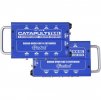Can you tell us what “specific” cases the unit is designed for?
In my own experience, this would be super useful for quickly testing different runs to find the source of a ground loop in a large scale live audio production scenario, without getting out a multimeter and unprofessionally jumpering and alligator-clipping a bunch of things together to get a testable scenario.
Ground loops can be really, really difficult to track down when you have dozens (or more) mic and instrument runs coming to and from different systems via long stage snake XLR bundles, sometimes involving multiple stages of performers with radically different equipment being attached to the other end of the snake, sometimes at a great distance where you have to coordinate with the staff at the other end entirely over radio. Imagine a stage changeover situation at a large music festival or other multi-performer production context, where performers are arriving with just an hour or so to spare and there's only a 30min or so reset interval between performances on a single stage. Sometimes those performers show up with really strange instrumentation, unusual boutique microphones, or situations where they have highly customized or finicky pickup situations on unusual instruments, sometimes that are also connected to mains AC power in ways that can get really weird.
I've personally seen a thing like this involving a vibraphone player with a neat little array of acoustic pickups on his vibes, and a ground loop that would start whenever the motor was plugged in to run the discs in his resonator tubes. Damn thing had shorted to the metal of the housing during transport. This stuff happens, and is really hard to diagnose on the fly when you have 20-ish minutes to make it perfect before a group takes the stage in front of 10k people. Not running the vibe motor is not an option, it doesn't sound like a vibraphone if it's not running, there's no vibrato. So you have to figure out how to make it work in a hurry. And that's just a simple case of a short. Imagine a case where a ground loop only exists when two different unrelated instruments are plugged in at the same time, and they only "touch" electrically through your board, or occasionally through the interaction of those instruments and some kind of other equipment in your rack.
A bag with a few of these things in different input/output connector formats (XLR to XLR being the most common) would be
invaluable in helping to rapidly track down the source of a ground loop problem. I wouldn't leave one in the signal path except in an emergency, but WOW would it be a time saver when you suddenly have some kind of crazy hum and it's not obvious exactly where it's coming from. And for a lot of the cases where this would be used, you don't have any signal below 100hz anyway, so it doesn't matter if it distorts at 50hz because the instrument doesn't play in that range. People certainly don't sing that low, in the case of a microphone.
The design of this thing seems obvious to me... figure out how to make a really simple and effective isolation transformer that can be inserted in a signal path quickly, and make it small enough to make a "kit" out of them in somebody's gig bag without adding an insane amount of weight. It doesn't have to be the last word in audio quality, it just needs to be effective, and "good enough" to be used in the signal path in an absolute emergency if there's no way to kill a ground loop at the actual source because of some weird situational constraint.
Hope that helps... I know it's a wall of text but those are my thoughts on this. It's simply not a device that I would try to use in a hifi context, it seems to me to not be what it's designed or intended to do.


